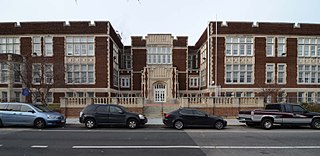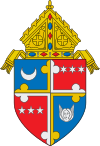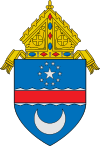
Knoxville College is a historically black liberal arts college in Knoxville, Tennessee, United States, which was founded in 1875 by the United Presbyterian Church of North America. It is a United Negro College Fund member school. A slow period of decline began in the 1970s, and by 2015, the school had an enrollment of just 11 students. In May 2015, the College suspended classes until Fall 2016 term in hopes of reorganizing. On May 17, 2018, the Tennessee Higher Education Commission gave its approval for Knoxville College to once again reopen its doors and offer classes. On July 1, 2018, Knoxville College website announced resumption of enrolling students for fall 2018 semester.

The University of the District of Columbia (UDC) is a public historically black land-grant university in Washington, D.C. It was established in 1851 and is the only public university in the city. UDC is a member school of the Thurgood Marshall College Fund. The full university system offers workforce and certificate programs in addition to Associate, Baccalaureate, Master's, professional, and Doctoral degrees. The university's academic schools and programs include the UDC Community College, College of Arts and Sciences, School of Engineering and Applied Sciences, School of Business and Public Administration, Colleges of Agriculture, Urban Sustainability & Environmental Sciences, and David A. Clarke School of Law.

The Historical Society of Washington, D.C., also called the DC History Center, is an educational foundation dedicated to preserving and displaying the history of Washington, D.C. The society provides lectures, exhibits, classes, and community events. It runs a museum, library, and publishes the journal Washington History. It had been named The Columbia Historical Society from its founding in 1894 until 1988.
Trinity Washington University is a Catholic university in Washington, D.C. There are five schools within the university; the undergraduate College of Arts & Sciences maintains its original status as a liberal arts women's college, while men attend Trinity's other schools at both the graduate and undergraduate level.

Eleutherian College, which was listed on the National Register of Historic Places in 1993 and declared a National Historic Landmark in 1997, was founded as Eleutherian Institute in 1848 by a group of local anti-slavery Baptists at Lancaster in Jefferson County. The institute's name comes from the Greek word eleutheros, meaning "freedom and equality." The school admitted students without regard to ethnicity or gender, including freed and fugitive slaves. Its first classes began offering secondary school instruction on November 27, 1848. The school was renamed Eleutherian College in 1854, when it began offering college-level coursework. It is the second college in the United States west of the Allegheny Mountains and the first in Indiana to provide interracial education. The restored three-story stone chapel and classroom building was constructed between 1853 and 1856 and presently serves as a local history museum.
The District of Columbia Public Schools (DCPS) is the local public school system for the District of Columbia, in the United States. DCPS should not be confused with the independently governed District of Columbia Public Charter Schools (DCPCS), which also operates in the District of Columbia.
School Without Walls High School (SWW) is a small public magnet high school in the Foggy Bottom neighborhood of Washington, D.C. It is colloquially referred to by students and faculty as "Walls". The school is based on a concept in urban education that encourages students to "use the city as a classroom", which is the origin of its name.
The Howard County Public School System (HCPSS) is the school district that manages and runs the public schools of Howard County, Maryland. It operates under the supervision of an elected, eight-member Board of Education. Dr. Chao Wu is the Chairman of the Board. Michael J. Martirano has served as the Superintendent since May 2017.

The Smithville Seminary was a Freewill Baptist institution established in 1839 on what is now Institute Lane in Smithville-North Scituate, Rhode Island. Renamed the Lapham Institute in 1863, it closed in 1876. The site was then used as the campus of the Pentecostal Collegiate Institute and later the Watchman Institute, and is now the Scituate Commons apartments. It was placed on the National Register of Historic Places in 1978.

Normal School for Colored Girls established in Washington, D.C., in 1851 as an institution of learning and training for young African-American women, especially to train teachers.

Myrtilla Miner was an American educator and abolitionist whose school for African American girls, established against considerable racist opposition, grew into the only public university in Washington, D.C.

The Charles Sumner School, established in 1872, was one of the earliest schools for African Americans in Washington, D.C. Named for the prominent abolitionist and United States Senator Charles Sumner, the school became the first teachers' college for black citizens in the city and the headquarters of its segregated school system for African American students. It currently houses a small museum, a research room, art exhibits, and the archives of the District of Columbia Public Schools.

Friendship Armstrong Academy is a public charter school located in the Truxton Circle neighborhood of Washington, D.C. Historically a black school, it is housed in the former Armstrong Manual Training School, also known as the Samuel Chapman Armstrong Technical High School.

The Reno School is a historic school building located at 4820 Howard Street NW, completed in 1903 to serve the needs of the Reno community in Washington, D.C. Like all public schools in the District at the time, it was segregated and served African American students in the area west of Rock Creek Park and north of Georgetown. The school was closed in 1950 after the Reno community was evicted to create Fort Reno Park and the adjacent Alice Deal Middle School.
Latin American Montessori Bilingual Public Charter School is a public charter school in Washington, D.C.. It operates in two buildings in the Northwest and Northeast quadrants of the city: one on 14th Street in Northwest's Sixteenth Street Heights and one at the corner of Perry Street and South Dakota Avenue in Northeast's Brookland neighborhood.

William Syphax School, now known as Syphax Village, is a historic structure located in the Southwest Quadrant of Washington, D.C. It was listed on the National Register of Historic Places in 2003.

Shaw Junior High School, now known as Asbury Dwellings, is an historic structure located in the Shaw neighborhood of Washington, D.C. It has been listed on the District of Columbia Inventory of Historic Sites and on the National Register of Historic Places since 2008.

John Mercer Langston School is an historic structure located in the Truxton Circle neighborhood in Washington, D.C. The two-story brick building was designed by Appleton P. Clark, Jr. The structure was completed in 1902. It was listed on the National Register of Historic Places in 2013.

Bruce-Monroe Elementary School at Park View is a bilingual elementary school in Washington, D.C.. Named after Blanche Bruce and James Monroe, it has been located in the historic Park View School in the city's Park View neighborhood since 2008. It is part of the District of Columbia Public Schools.
Israel Metropolitan Christian Methodist Episcopal Church is a Christian Methodist Episcopal Church in Washington, D.C. It was the first independent African American church of the city.



















